Bill Kluge
Reviews By Author
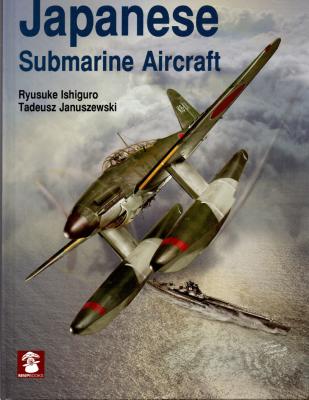
|
Japanese Submarine AircraftPublished:
Following the lead of the German Navy in WWI, several countries, including Britain, France, the United States, Italy and the Soviet Union all pursued development of aircraft capable of submarine transport, as well as the submarines capable of carrying them. But no country more so than Japan carried the development of these aircraft and naval vessels to the logical conclusion. During the 1920s, Japan purchased aircraft technology from Germany and submarines from France and Great Britain, and using them as a starting point, developed the most successful submarine launched aircraft and aircraft carrying submarines of any navy before and during WWII. The first chapter of this book covers the early development of submarine aircraft operational procedures and strategy, followed by a… more |

|
Sprue Cutter (Basic/Rough Cut)Published:
Squadron’s Basic Sprue Cutter is the foundation tool in Squadron’s three-piece collection of cutters, a collection that includes a Precision Cutter and a High Precision Cutter. These tools can be purchased individually or in a 3-piece set. This Basic Cutter is designed to remove larger, less fragile parts from sprue trees, as well as to render large trees into smaller, more manageable ones. As with any cutter, it can be used to remove any part from its tree, depending on the finesse of the operator. This tool is exceptionally sharp and cuts very cleanly for a “basic” cutter. Its 5” length is easy to grip, with well-padded handles. The only downside that I found was the relative narrowness of its opening, a modest 5mm at maximum spread. For comparison, the photos show my… more |

|
Ultimate Razor Saw - Ultra SmoothPublished:
Be Izzi is a relatively new company from the Czech Republic specializing in hobby tools. This item, the Ultimate Razor Saw, is comprised of a standard handle with a straight attachment fixture and their Ultra Smooth, 0.1mm thick razor saw blade. This tool is actually a system, with interchangeable straight, curved or Y-shaped attachment fixtures and blades of different cutting variations - basic rough-cut blades to “Ultra Smooth” very fine toothed blades. The blades can be mounted in a number of different positions and/or angles to facilitate a variety of cutting positions or angles. The tool includes it’s own small Allen wrench tucked away at the bottom of the handle (easy to miss if you don’t know its there) to loosen and tighten the small set screws that allow for changing or… more |
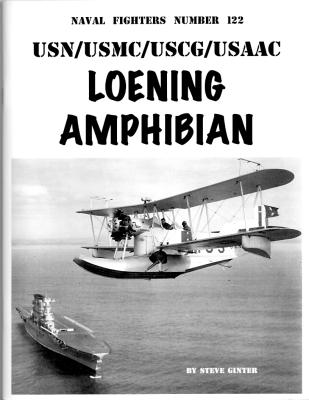
|
Loening Amphibian - USN/USMC/USCG/USAACPublished:
Grover C. Loening built his first airplane in 1918, the diminutive single seat M-2 Kitten monoplane, soon refined into the more powerful 2-seat M-8 that was accepted and purchased by the Army Air Corps. However, due to the resistance towards monoplanes he reverted to a biplane configuration in creating his most successful design six years later, the OL amphibian. The Loening OL and it’s derivatives would soldier on with the Army, Navy, Marine Corps and Coast Guard for another decade. Author Steve Ginter describes the development of the Navy’s OL-1 thru -7 and Army OA-1 and -2 liquid cooled Liberty and Packard-engined amphibians, as well as later P&W radial engined OL-8s. Development continued after the merger of the Loening and Keystone companies with the OL-9. Much of the… more |

|
Mitsubishi A6M Parts 3 & 4 Limited EditionPublished:
These two A6M decal sets from Lifelike continue the series of markings for the A6M Zero provided by earlier sets 48061 and 48062. Part 3 (48063) contains markings for 14 aircraft: 2 Type 11s; 7 Type 21s; 4 Type 52s and 1 A6M2-N Rufe. The specific aircraft include:
|
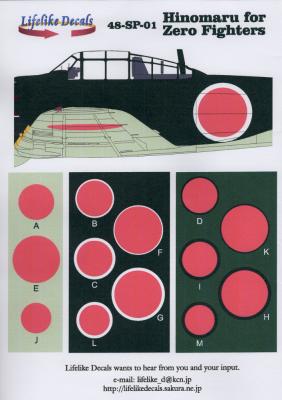
|
Mitsubishi A6M Hinomarus Decal SetPublished:
Lifelike Decals has released this sheet of decals for Zero fighters to correct what it describes as erroneous sizing of Hinomarus in some manufacturer’s kits. Their website states:
”We noticed that some Zero kits decals etc. do not have correct size Hinomaru marks, so we released “Hinomaru for Zero” sheet separately”.
The Hinomarus come it three distinct types - with the white surround (both wide and thin); without the white surround; and with green overpainted surround, with enough Hinomarus for a half dozen different aircraft. The decals are thin, with minimal carry-over of the carrier film (approx. 1mm). They come off the paper quickly, were easy to adjust into place, and reacted well to Solvaset decal softener to conform to surface bumps and… more |
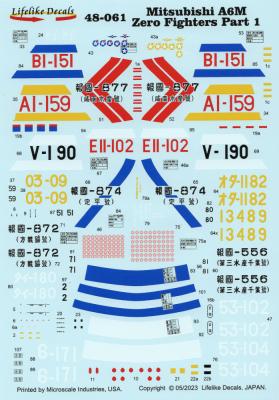
|
Mitsubishi A6M Decal SetsPublished:
These two new A6M decal sets from Lifelike represent a bonanza of marking options for the Zero builder. Part 1 (48061) contains markings for 14 aircraft: 5 Type 21s; 2 Type 22s; 4 Type 32s; 2 Type 52s and 1 A6M2-N Rufe. The specific aircraft include:
|

|
IJNMS Yamato, Part 4, Final AssemblyPublished:
Now that the major subassemblies are complete, it was time to put the pieces of the jigsaw puzzle together. I naively thought that it would all be downhill from here, even if it was a gently sloping downhill. I didn’t quite realize how many lengthy flat spots there would be along the way. The larger assemblies of superstructure, stack, and main and secondary armament structures fell into place easily with good, secure fitting. I had numerous smaller 25mm AA turrets and directors (all assembled and painted in mass earlier) still to place, as well as many open 25mm triple and single mounts still to assemble and place. By late in the war Yamato had over twenty single mounts placed along the deck, from far aft to astride her main turrets. While the kit offers enough triple mounts, it… more |
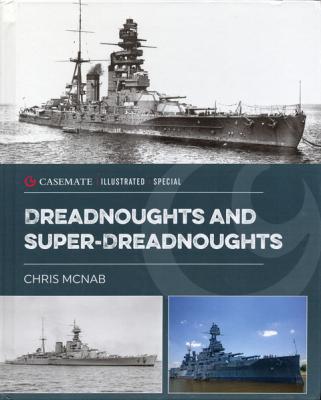
|
Dreadnoughts and Super-DreadnoughtsPublished:
By the turn of the Twentieth Century, Great Britain was at the height of its industrial and colonial power, with the largest ironclad navy in the world. By 1904, Britain ruled the seas with 45 “pre-dreadnaught” battleships. Each of these carried a main armament usually consisting of four 12- or 13-inch main guns in two twin turrets (one forward and one aft) along with a number of lesser caliber weapons (6”, 12-pounder and 3-pounder) for close in defense. Other navies, primarily Germany, the United States, and after 1905 Japan followed on Great Britain’s heels. The stage was set for an abrupt alteration in the status quo, as industry, technology and the critical thinking of one man combined to change the face of naval power in the decades to come. Author Chris McNab chronicles… more |
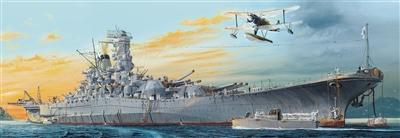
|
IJMNS Yamato, Part 3Published:
Building a battleship, especially one this large and complex, can easily appear overwhelming. So, as with any large model project, its easiest to tackle it as a series of subassemblies. That’s more or less the way the instruction sequence is arranged, and it simplifies painting, if nothing else (I found out the hard way that the Tamiya spray can and the bottle lacquer are not the same shade of Kure Grey - too different to use the two together). So everything on this model is painted from the bottle through the airbrush. Otherwise, the Tamiya lacquer goes on beautifully. The hull and deck were masked and painted the appropriate grey and wood tan, with the night safety deck markings (white rectangles spaced along the deck edge) then added. I decided to darken the deck before… more |
